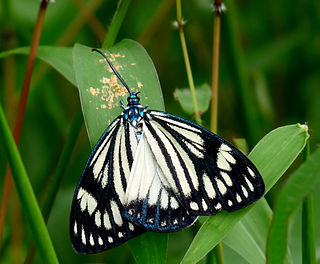
The Zygaenidae moths are a family of Lepidoptera. The majority of zygaenids are tropical, but they are nevertheless quite well represented in temperate regions. Some of the 1000 or so species are commonly known as burnet or forester moths, often qualified by the number of spots, although other families also have 'foresters'. They are also sometimes called smoky moths.

The Tortricidae are a family of moths, commonly known as tortrix moths or leafroller moths, in the order Lepidoptera. This large family has over 11,000 species described, and is the sole member of the superfamily Tortricoidea, although the genus Heliocosma is sometimes placed within this superfamily. Many of these are economically important pests. Olethreutidae is a junior synonym. The typical resting posture is with the wings folded back, producing a rather rounded profile.

The winter moth is a moth of the family Geometridae. It is an abundant species in Europe and the Near East and a famous study organism for evaluating insect population dynamics. It is one of very few lepidopterans of temperate regions in which adults are active in late autumn and early winter. The adults use endothermy for movement in these cold temperatures. The females of this species are virtually wingless and cannot fly, but the males are fully winged and fly strongly. After the initial frosts of late fall, the females emerge from their pupae, walk to and up trees and emit pheromones in the evening to attract males. After fertilization, they ascend to lay, on average, around 100 eggs each. Typically, the larger the female moth is, the more eggs she lays.

Carposinidae, the "fruitworm moths", is a family of insects in the order Lepidoptera. These moths are narrower winged than Copromorphidae, with less rounded forewing tips. Males often have conspicuous patches of scales on either surface. The mouthparts are quite diagnostic, usually with prominent, upcurved "labial palps", the third segment long, and the second segment covered in large scales. Unlike Copromorphidae, the "M2" and sometimes "M1" vein on the hindwings is absent. The relationship of Carposinidae relative to Copromorphidae needs further investigation. It is considered possible that the family is artificial, being nested within Copromorphidae. The Palearctic species have been revised by Alexey Diakonoff (1989).
Sex pheromones are pheromones released by an organism to attract an individual of the same species, encourage them to mate with them, or perform some other function closely related with sexual reproduction. Sex pheromones specifically focus on indicating females for breeding, attracting the opposite sex, and conveying information on species, age, sex and genotype. Non-volatile pheromones, or cuticular contact pheromones, are more closely related to social insects as they are usually detected by direct contact with chemoreceptors on the antennae or feet of insects.

Dioryctria sylvestrella, the new pine knot-horn or maritime pine borer, is a moth of the family Pyralidae. It is found in Europe, parts of Asia and North Africa. The adult is a small mottled brown and white insect with a wingspan of 28 to 35 mm. The moth flies in a single generation from June to October and is a pest of maritime pine and several other species of pine, on which the caterpillars feed.

Schinia cognata is a moth of the family Noctuidae. It is found in south-eastern Europe and Turkey.
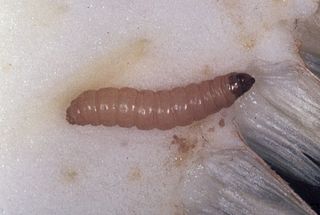
Suleima is a genus of moths belonging to the subfamily Olethreutinae of the family Tortricidae.
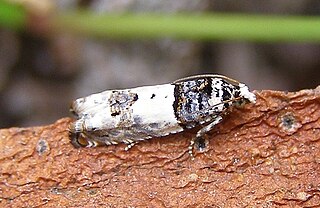
Gypsonoma sociana is a moth of the family Tortricidae. It is found from Europe to Russia, China and Japan.
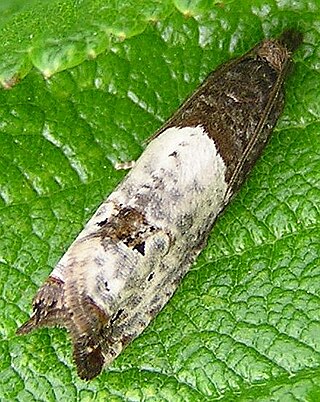
Notocelia roborana is a moth of the family Tortricidae. It is found from Europe to eastern Russia. It is also found in Asia Minor, Iran, Mongolia and China (Xinjiang).

Zeiraphera ratzeburgiana, the spruce bud moth or Ratzeburg tortricid, is a moth of the family Tortricidae. It is found from northern and central Europe to eastern Russia and China. Zeiraphera ratzeburgiana is a taxonomically similar species to Zeiraphera canadensis and can only be distinguished by an anal comb found in Z. canadensis.

The Eucosmini are a tribe of tortrix moths.

Sphenarches anisodactylus, commonly known as the geranium plume moth, is a species of moth in the family Pterophoridae. It is found in western Africa, Madagascar, India, Sri Lanka, Thailand, Japan, the New Hebrides and Central and South America, as well as Australia, where it has been recorded from Cape York to central New South Wales. It is found in the United States, where it has been recorded from Florida, as well as Mississippi. It is also present in the Kermadec Islands of New Zealand.
Nippoptilia cinctipedalis is a moth of the family Pterophoridae. It is found in Australia, Korea, Japan (Kyushu), China, Micronesia, the Republic of Palau and Vietnam.

Gypsonoma dealbana, the common cloaked shoot, is a moth of the family Tortricidae.

The currant shoot borer moth is a species of moth of the family Prodoxidae. It is found in most of central, northern and eastern Europe. It is also found in North America.
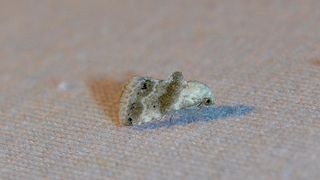
Eublemma minima, the everlasting bud moth, is a moth of the family Erebidae. The species was first described by Achille Guenée in 1852. It is found in Kenya, Madagascar, South Africa and Yemen, as well as in the United States, Brazil, Argentina, Caribbean and Paraguay.
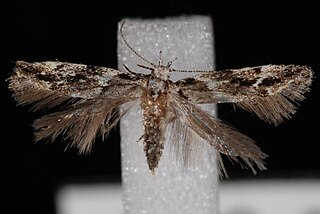
Recurvaria nanella, the lesser bud moth, is a moth of the family Gelechiidae. It is widely distributed in Europe and is also found in Turkey, the Near East, North Africa, the Caucasus, Transcaucasia, Kazakhstan and south-eastern Siberia. It is also found in North America, where it is probably introduced.
Spilonota albicana, the white fruit moth, larger apple fruit moth or eye-spotted bud moth, is a species of moth of the family Tortricidae. It is found in China, Korea, Japan and Russia. It has been accidentally introduced in the Netherlands.



















